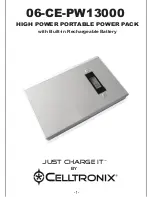
Verification 13
Programming the Tests
General Considerations
Procedures are given for programming these tests either from the front panel keypad or from a GPIB controller for a GPIB
controller for 667xA system supplies. The procedures assume you know how to use the front panel keypad or how to
program over the GPIB (see the Power Supply Operating Manual for more information). When using computer-controlled
tests, you may have to consider the relatively slow (compared to computer and system voltmeters) settling times and slew
rates of the power supply. Suitable
WAIT
statements can be inserted into the test program to give the power supply time to
respond to the test commands.
Hazardous voltages may be present at the power supply output during these tests. They should be
performed only by qualified electronics personnel.
Programming Parameters
Table 2-2 lists the programming voltage and current values for each model. You can enter these values either from the front
panel or from a controller over the GPIB (for system power supplies).
Table 2-2. Programming Voltage and Current Values
Agilent Model
Full Scale
Max. Prog.
Full Scale
Max. Prog.
Max. Prog.
-CC
Voltage
Voltage
Current
Current
Overvoltage
Current
Agilent 6571A, 6671A
8V
8.190V
220A
225.23A
10V
10A
Agilent 6572A, 6672A
20V
20.475V
100A
102.37A
24V
10A
Agilent 6573A, 6673A
35V
35.831V
60A
61.43A
42V
5A
Agilent 6574A, 6674A
60V
61.425V
35A
35.83A
72V
4A
Agilent 6575A, 6675A
120V
122.85V
18A
18.43A
144V
2.5A
General Measurement Techniques
Figure 2-1 shows the setup for most tests. Measure the dc output voltage directly at the sense (
+S
and
-S
) terminals.
Connect these terminals for
remote sensing
(to the
+LS
and
-LS
terminals). Be certain to use load leads of sufficient wire
gauge to carry the output current (see Chapter 4 of the Power Supply Operating Manual). To avoid noise pickup, use
coaxial cable or shielded pairs for the test leads. If you use more than one meter or a meter and an oscilloscope, connect
separate leads for each instrument to avoid mutual-coupling effects.
Performance Test Record Sheets
When performing the tests in this chapter, refer to the Performance Test Record sheets supplied at the end of this chapter.
Table 2-6 is for recording common information, such as, the test equipment used and the environmental conditions. Tables
2-7 through 2-11 are dedicated to specific models and contain the acceptable test values and ranges. A place is provided to
record the results of the test.
Summary of Contents for 6571A
Page 10: ......
Page 33: ...Troubleshooting 33 Figure 3 1 Overall Troubleshooting Sheet 1 of 4...
Page 34: ...34 Troubleshooting Figure 3 1 Overall Troubleshooting Sheet 2 of 4...
Page 35: ...Troubleshooting 35 Figure 3 1 Overall Troubleshooting Sheet 3 of 4...
Page 36: ...36 Troubleshooting Figure 3 1 Overall Troubleshooting Sheet 4 of 4...
Page 37: ...Troubleshooting 37 Figure 3 2 No Display Troubleshooting...
Page 38: ...38 Troubleshooting Figure 3 3 OV Will Not Fire Troubleshooting...
Page 39: ...Troubleshooting 39 Figure 3 4 OV At Turn On Troubleshooting Sheet 1 of 2...
Page 40: ...40 Troubleshooting Figure 3 4 OV At Turn On Troubleshooting Sheet 2 of 2...
Page 41: ...Troubleshooting 41 Figure 3 5 Output Held Low Troubleshooting Sheet 1 of 2...
Page 42: ...42 Troubleshooting Figure 3 5 Output Held Low Troubleshooting Sheet 2 of 2...
Page 43: ...Troubleshooting 43 Figure 3 6 Output Held High Troubleshooting...
Page 44: ...44 Troubleshooting Figure 3 7 DAC Circuits Troubleshooting...
Page 45: ...Troubleshooting 45 Figure 3 8 DAC Test Waveforms...
Page 46: ...46 Troubleshooting Figure 3 9 CV CC DAC and Amplifier Circuit Troubleshooting...
Page 47: ...Troubleshooting 47 Figure 3 10 Serial Down Troubleshooting Sheet 1 of 2...
Page 48: ...48 Troubleshooting Figure 3 10 Serial Down Troubleshooting Sheet 2 of 2...
Page 49: ...Troubleshooting 49 Figure 3 11 Isolator Board Troubleshooting...
Page 50: ...50 Troubleshooting Figure 3 12 Secondary Interface Down Sheet 1 of 2...
Page 51: ...Troubleshooting 51 Figure 3 12 Secondary Interface Down Sheet 2 of 2...
Page 52: ...52 Troubleshooting Figure 3 13 Slow Downprogramming Troubleshooting...
Page 55: ...Troubleshooting 55 Figure 3 14 A3 FET Board Test Waveforms...
Page 59: ...Troubleshooting 59 Figure 3 17 Signature Analysis Connections for Model 657xA Only...
Page 60: ...60 Troubleshooting Figure 3 17 Signature Analysis Connections for Model 667xA Only...
Page 75: ...Troubleshooting 75 Figure 3 20 Component Locations Top Cover and RFI Shield Removed...
Page 76: ......
Page 83: ...Principles Of Operation 83 Figure 4 1 Agilent Series 665xA 667xA Power Supply Block Diagram...
Page 84: ......
Page 124: ...124 Diagrams Figure 6 1 Test Point Waveforms for Table 6 3...
Page 125: ...Diagrams 125 Figure 6 2 Circuit Board Cabling Diagram...
Page 126: ...126 Diagrams Figure 6 3 A1 Front Panel Board Component Location Diagram...
Page 127: ...Figure 6 4 A1 Front Panel Board Schematic Diagram...
Page 128: ...Figure 6 5 A2 GPIB Board Assembly Diagram 667xA only...
Page 129: ...2 3 4 1 6 5 Figure 6 6 A2 GPIB Board Schematic Diagram 667xA only 7 8...
Page 130: ...Figure 6 7 A3 FET Board Assembly Diagram and Test Point Locations...
Page 135: ...Figure 6 12 A5 Board Sec CV CC Readback DACs Schematic sheet 1 64 37 38 36 39 40...
Page 136: ...Figure 6 12 A5 Board CV CC Control Circuits Schematic sheet 2 40 45 46 39 41 42 47 43 48 44...
Page 138: ...Figure 6 13 A6 Output Filter A7 Snubber Boards Assembly Diagrams 65 6671A 72A...
Page 140: ...Figure 6 15 A6 Output Filter A7 Snubber Boards Assembly Diagrams 65 6673A 74A...
Page 142: ...Figure 6 17 A6 Output Filter A7 Snubber Boards Assembly Diagrams 65 6675A...
Page 143: ...Figure 6 18 A2 Isolator Board Assembly and Schematic Diagram for 654xA 655xA Models Only...
Page 154: ......














































